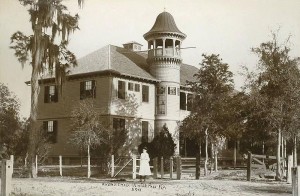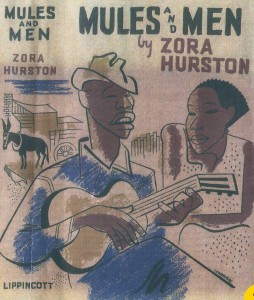Apr
2
2010
It’s that time of the year when thoughts turn to escape! Getting out of the cold. Getting away from the reality of harsher places. Time to head south from north, or across the country to palm trees and beaches.
A how-to article on following Zora’s Florida roust-abouts just found some space in the New York Times.
And if that doesn’t satisfy your wanderlust, buy a copy of my film Jump at the Sun for the real story.
no comments | posted in Interesting Posts, Zora Neale Hurston
Mar
31
2010
Zora Neale Hurston’s name is almost synonymous with the Harlem Renaissance. Yet, she spent only a modest amount of her time in Harlem during the decade it flourished as an incubator for black arts in America, from 1920 until the stock market crashed in 1929, launching the Great Depression.
 Zora arrived in New York in 1925 and in 1927 she was given a 16-mm camera and a car by her patron Charlotte Osgood Mason, and immediately headed south to Florida. A majority of the footage from 1927 consists of children playing games. Researcher Keith Bollum has identified the location as Loughman, Florida, the site of an immense central Florida lumber yard and sawmill, the same place where Zora gathered stories for her anthropological collection Mules and Men. Other footage appears to be Bartow where she documented a medical “root doctor” whom she also wrote about in Mules and Men. She side-tracked to Mobile Alabama, interviewing and filming Cudjo Lewis, the last living African to have made the Journey of the Middle Passage to America as a slave (on an illegal slave ship, as slave transport had been banned). Unfortunately, the audio didn’t survive, and neither did footage of “the Zulu Crew” from New Orleans, nor dancers on a beach (a list Mason created describing Zora’s footage is in an archive at Howard University). Because Zora’s interest was black folk culture, she shot footage at baseball bleechers in Florida, most likely one used by the Negro Leagues, and yet she filmed the average folks in the stands but not the players.
Zora arrived in New York in 1925 and in 1927 she was given a 16-mm camera and a car by her patron Charlotte Osgood Mason, and immediately headed south to Florida. A majority of the footage from 1927 consists of children playing games. Researcher Keith Bollum has identified the location as Loughman, Florida, the site of an immense central Florida lumber yard and sawmill, the same place where Zora gathered stories for her anthropological collection Mules and Men. Other footage appears to be Bartow where she documented a medical “root doctor” whom she also wrote about in Mules and Men. She side-tracked to Mobile Alabama, interviewing and filming Cudjo Lewis, the last living African to have made the Journey of the Middle Passage to America as a slave (on an illegal slave ship, as slave transport had been banned). Unfortunately, the audio didn’t survive, and neither did footage of “the Zulu Crew” from New Orleans, nor dancers on a beach (a list Mason created describing Zora’s footage is in an archive at Howard University). Because Zora’s interest was black folk culture, she shot footage at baseball bleechers in Florida, most likely one used by the Negro Leagues, and yet she filmed the average folks in the stands but not the players.
This early footage documented precisely the culture and people Zora wrote about in her books and was an important asset for my film, Jump at the Sun.
no comments | posted in About Filmmaking, Zora Neale Hurston
Mar
26
2010
Sunday March 28 at 2P there will be a screening of Jump at the Sun at the Winter Park Public Library at 460 East New England Avenue. The photo below is Knowles Hall at Rollins College in Winter Park, turn of the century.
 Over my years of working on the film, I encountered quite a few people from Winter Park who bubbled over with their own recollections of Zora Neale Hurston, the acclaimed author of Their Eyes Were Watching God, and one of the first African-American anthropologists. Zora’s hometown of Eatonville was separated from Winter Park by a large lake or two but that didn’t stop Zora from jumping in her model-A and rumbling down Orange, Orlando, Park or Fairbanks Avenues, getting together with her white friends to play croquet. According to Zora’s niece, Winnifred Hurston Clarke, the folks in Eatonville frowned on this. And they also frowned on Zora’s lack of attendance in church on Sundays. And that’s what life in a small town was like back then. We’re fortunate that Zora created an aura that inspired so much adulation and memories in both cities.
Over my years of working on the film, I encountered quite a few people from Winter Park who bubbled over with their own recollections of Zora Neale Hurston, the acclaimed author of Their Eyes Were Watching God, and one of the first African-American anthropologists. Zora’s hometown of Eatonville was separated from Winter Park by a large lake or two but that didn’t stop Zora from jumping in her model-A and rumbling down Orange, Orlando, Park or Fairbanks Avenues, getting together with her white friends to play croquet. According to Zora’s niece, Winnifred Hurston Clarke, the folks in Eatonville frowned on this. And they also frowned on Zora’s lack of attendance in church on Sundays. And that’s what life in a small town was like back then. We’re fortunate that Zora created an aura that inspired so much adulation and memories in both cities.
Zora often described herself as the Florida Chamber of Commerce, sitting on her gate post, enticing tourists with her antics, querying them with “don’t you want me to go a piece of the way with you?” She managed to lure Fannie Hurst and the travel writer for the New York World Telegram to visit Winter Park in its tourist heyday.
Please stop by for the film. And bring your stories as we all like to hear them. The filmmaker (me!) will be in attendance.
no comments | posted in Events, Jump At The Sun Screenings, Zora Neale Hurston
Mar
23
2010
I just read a reviewers comments about a local film festival in my area. They particularly liked one of the films and suggested that it “deserved a distribution deal”. But it is becoming increasingly hard for a film to find distribution, whether it’s broadcast, theatrical, or even home distribution. Only 18 films at the 2008 Sundance festival found distribution deals.
But now distribution gurus are suggesting filmmakers do it themselves.
My film was picked up for broadcast distribution by PBS’ American Masters, and they wanted the privilege of premiering the film on television. The broadcast disqualified my film from many festivals, where distribution deals are made, because many festivals won’t include films that are already broadcast.
But my film had broad interest from fans of the film and fans of Zora Neale Hurston, so I was able to find an educational distributor to sell the film to schools and libraries (California Newsreel). I then decided to self-distribute the film to the home market, and undertook the expenses to create the master and DVD copies. I sell it on Amazon, and I book community screenings where I sell the DVDs. While I might not have the potential to reach as broad an audience as a major distributor would, I’m able to keep a much greater percentage of sales than a distributor would allow.
So if your film does not get picked up for distribution, don’t despair. Be creative and find a niche market. Use your viral marketing skills to let people know about the film (Facebook and Twitter, for starters). And good luck!
no comments | posted in About Filmmaking
Mar
19
2010
Who was the coolest of the cool, long before it was cool? In 1933 an unknown writer by the name of Zora Neale Hurston became the very first documented writer to use the world “cool” to imply hip-ness. 
In her short story The Gilded Six Bits written for Story Magazine (1933), the conversation between two poor but devoted lovers turns to the local town big-shot who not only has a mouth full of gold teeth but also money in the bank: “What make it so cool, he got money ‘cumulated.” Then in 1934 in Jonah’s Gourd Vine, Zora keeps her “cool” going as she describes a man as not only a good guitar picker but also good looking (“What make it so cool, he de’ bes’ lookin’). Then again in 1935, as scholar Robert Farris Thompson notes in my film JUMP AT THE SUN, a man flirting with his girlfriend dishes up some cool when he tells her he’ll be making her breakfast in the morning: “Whut make it so cool, ah’d fix you some, and set it on de back of de cook-stove so you could git it when yo’ wake up.”
As for that Beat Generation, it wasn’t until 1948 that “cool” was next found in a New Yorker magazine quote about jazz.
1 comment | posted in Zora Neale Hurston


